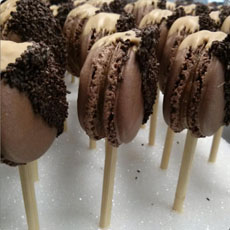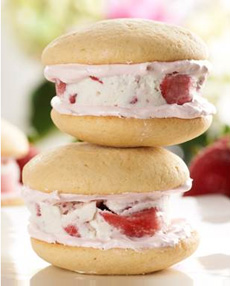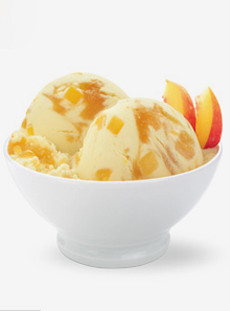
Look for deals on basil and make pesto.
Photo courtesy PreciseNutrition.com. |
|
Our greenmarkets are flooded with huge bunches of basil, just beckoning to be made into pesto sauce. Pesto traditionally* consists of basil, garlic, olive oil, pine nuts, Parmesan and Pecorino cheeses, plus a pinch of salt. It originated in the Italian province of Liguria, 220 miles of crescent-shaped Mediterranean coastline that is sometimes called the Italian Riviera—and produces the sweetest, mildest basil.
The capital of Liguria is Genoa, and the region’s classic pesto is known as pesto alla genovese (jen-oh-VAY-zay). Ligurians take such great pride in their sauce, that they have sought D.O.P. status for pesto produced in the area (an official labeling that distinguishes a product for its authenticity and excellence and protects the use of the name).
The sauce gets its name from the word pestle; a mortar and pestle are the traditional device used to make pesto.
For centuries, pesto was used mostly as a condiment, to flavor vegetable soups. It wasn’t until 1910 that it began to be used as a sauce for pasta.
|
*Earlier versions of Ligurian pesto used parsley or marjoram instead of basil, and did not include the pine nuts. Delicious pestos can be made with arugula or other green, and with walnuts or hazelnuts. Regions that have an abundance of those nuts will make the substitution. Some recipes use a combination of Parmesan and Pecorino cheeses; others use only one. Some add butter to the pesto for added creaminess. Ligurian cooks have also been known to occasionally incorporate cooked potato into the sauce. At times, they combine pesto with tomatoes, or add a light, fresh cheese, like ricotta or prescineua, a cultured cheese similar to yogurt or crème fraîche.
WAYS TO USE PESTO
Traditional preparations with pesto include trenette, flat ribbon pasta similar to linguine but with ridges the pesto can clink to; and triofe alla Genovese, dumpling-like, rolled, worm-shaped pasta with crevices for pesto to fill. With the latter dish, small pieces of potato are boiled with the dry pasta, and when they’re almost done, string beans are added to the boiling liquid. The three ingredients are then tossed with pesto, adding some starchy cooking water to help it coat.
How else can you use pesto?
Bruschetta: Spread pesto on toasted or grilled bread for an easy snack or hors d’oeuvre.
Caprese salad: Substitute pesto for the oil and fresh basil of a Caprese salad (bufala mozzarella and tomatoes).
Condiment: Spread pesto on sandwiches, straight or mixed into mayonnaise. That pesto-mayo will also spruce up your chicken and tuna salads, and make a fusion pesto-aïoli. Or, add some pesto to your marinade.
Dip: Use pesto as a dip with crudités or French fries; or mix it with mayonnaise, sour cream or yogurt for a creamy dip and sauce that goes with just about anything.
Fish and meats: Spoon pesto atop grilled, poached or roasted food, or spoon the pesto onto a plate and place the food on top of it. Like chimichurri† sauce, it’s really delicious on steak.
Pasta and pizza: Pesto can be used in lasagna, on gnocchi, and with any other shape of pasta. Just place a few spoonfuls in a bowl, add the cooked pasta and a touch of pasta cooking water, and stir. One of our favorite ways to serve this is with whole, toasted pine nuts, shredded prosciutto, freshly grated Parmesan and peas. We also drizzle it on pizza—both homemade and delivery.
Soup: A dollop of pesto, made without nuts, can be added to minestrone or other vegetable soup. In France, pistou is the name of a pesto-like sauce and the soup to which it is added.
Vegetables and grains: Pesto is delicious with potatoes, rice and other grains (barley, quinoa, etc.). Instead of parsley potatoes, think pesto potatoes.
Vinaigrette: Herb and garlic pestos make fabulous additions to vinaigrettes. Whisk a spoonful with some lemon juice and extra virgin olive oil, or add it to your favorite vinaigrette recipe.
†Chimichurri is a spicy vinegar-parsley sauce that is the leading condiment in Argentina and Uruguay, as salsa is to Mexico. It is made of chopped fresh parsley and onion, seasoned with garlic, oregano, salt, cayenne and black pepper, and bound with oil and vinegar; it is served with grilled meat.
|
|
PESTO ALLA GENOVESE, AKA PESTO CLASSICO
Ingredients
1 pinch coarse salt
60 small or 30 large fresh basil leaves, wiped, stems and spines removed
1 large or 2 small cloves garlic, peeled, any green shoots removed
3 tablespoons/22g pignoli nuts
2 tablespoons/15g fresh, finely grated Pecorino Sardo
2 tablespoons/15g fresh, finely grated Parmigiano-Reggiano
3 tablespoons/45 ml extra virgin olive oil (mild or fruity)
|
|

The result of your labors: delicious pesto. Photo by Loooby | IST..
|
Variations
If you’re not a huge basil fan, try arugula, cilantro or spinach pesto. Pesto doesn’t have to be green: You can make it from mushrooms, olives, red bell peppers or sundried tomatoes. You can add chipotle, honey, maple syrup, olives, roasted garlic or whatever appeals to you, to make your signature pesto.
Preparation
1. PLACE the sea salt and a few of the basil leaves in a mortar. Using a pestle, press and lightly pound the leaves and salt against the coarse bowl of the mortar, in a rotary motion, breaking the leaves apart. Keep adding a few more leaves and grinding them until you’ve used them all. Do not completely pulverize.
2. ADD the garlic and pound it until it releases its juices. Add the pignoli nuts and pound them into a paste. Move the pestle around the mortar to combine the ingredients.
3. STIR in the Pecorino and Parmigiano-Reggiano; then gradually add olive oil, stirring it into the paste (a spoon can be used for these steps, if you prefer). You should have a thick, creamy, homogenous, bright green sauce.
BLENDER OPTION
You can make pesto in a blender or food processor. We’ve done it both ways. Believe us, it tastes better when made with a mortar and pestle. If you want the ease of an electric appliance, choose the a blender.
1. COMBINE half the olive oil and all the ingredients, excluding the cheeses. Process, adding more oil, if necessary, to get the ingredients moving.
2. STOP the blender regularly to push the mixture down. Once a paste forms, stir in the cheeses, as well as additional olive oil, if desired.
MORE ON PESTO
Check out our article with reviews of the best ready-made pesto brands.
|
|








